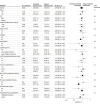Immediate- or Delayed-Intensive Statin in Acute Cerebral Ischemia: The INSPIRES Randomized Clinical Trial
- PMID: 38805216
- PMCID: PMC11134282
- DOI: 10.1001/jamaneurol.2024.1433
Immediate- or Delayed-Intensive Statin in Acute Cerebral Ischemia: The INSPIRES Randomized Clinical Trial
Abstract
Importance: Comparisons are limited for immediate-intensive and delayed-intensive statin for secondary stroke prevention and neuroprotection in patients with acute mild ischemic stroke or transient ischemic attack (TIA) from atherosclerosis.
Objective: To estimate whether immediate-intensive statin therapy is safe and can lower the risk of recurrent stroke compared with delayed-intensive statin in patients with acute mild ischemic stroke or high-risk TIA from atherosclerosis.
Design, setting, and participants: The Intensive Statin and Antiplatelet Therapy for High-Risk Intracranial or Extracranial Atherosclerosis (INSPIRES) trial, a double-blind, placebo-controlled, 2 × 2 factorial, randomized clinical trial enrolled patients from September 2018 to October 2022. The trial was conducted at 222 hospitals in China. Patients aged 35 to 80 years with mild ischemic stroke or high-risk TIA of presumed atherosclerosis within 72 hours of symptom onset were assessed.
Interventions: Patients were randomly assigned to receive immediate-intensive atorvastatin (80 mg daily on days 1-21; 40 mg daily on days 22-90) or 3-day delayed treatment (placebo for days 1-3, followed by placebo and atorvastatin, 40 mg daily on days 4-21, and then atorvastatin, 40 mg daily on days 22-90).
Main outcomes and measures: The primary efficacy outcome was new stroke within 90 days, and a secondary efficacy outcome was poor functional outcome. Moderate to severe bleeding was the primary safety outcome.
Results: A total of 11 431 patients were assessed for eligibility, and 6100 patients (median [IQR] age, 65 [57-71] years; 3915 men [64.2%]) were enrolled, with 3050 assigned to each treatment group. Within 90 days, new stroke occurred in 245 patients (8.1%) in the immediate-intensive statin group and 256 patients (8.4%) in the delayed group (hazard ratio, 0.95; 95% CI, 0.80-1.13). Poor functional outcome occurred in 299 patients (9.8%) and 348 patients (11.4%) in the immediate-intensive and delayed-intensive statin groups, respectively (odds ratio, 0.83; 95% CI, 0.71-0.98). Moderate to severe bleeding occurred in 23 of 3050 patients (0.8%) and 17 of 3050 patients (0.6%), in the immediate-intensive and delayed-intensive statin groups, respectively.
Conclusions and relevance: Immediate-intensive statin initiated within 72 hours did not reduce the risk of stroke within 90 days and may be associated with improved functional outcomes without significant difference in moderate to severe bleeding, compared with 3-day delayed-intensive statin in Chinese patients with acute mild ischemic stroke or TIA from atherosclerosis.
Trial registration: ClinicalTrials.gov Identifier: NCT03635749.
Conflict of interest statement
Figures



References
-
- Goldstein LB, Amarenco P, Zivin J, et al. ; Stroke Prevention by Aggressive Reduction in Cholesterol Levels Investigators . Statin treatment and stroke outcome in the Stroke Prevention by Aggressive Reduction in Cholesterol Levels (SPARCL) trial. Stroke. 2009;40(11):3526-3531. doi:10.1161/STROKEAHA.109.557330 - DOI - PubMed

